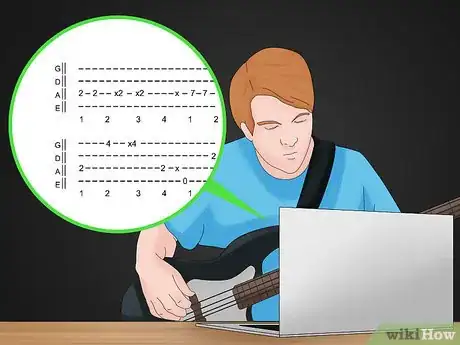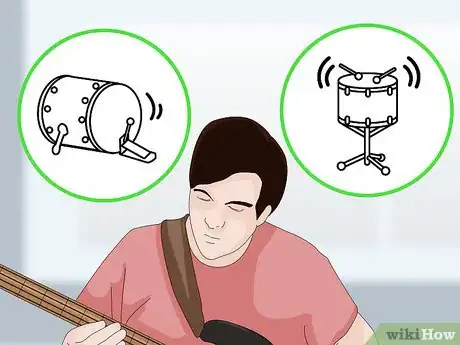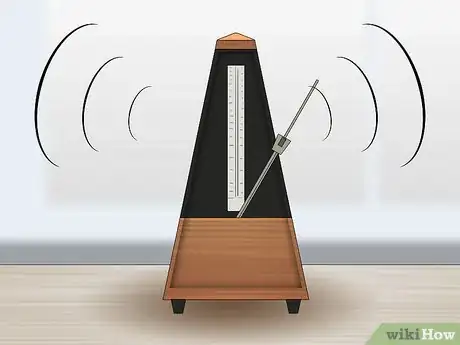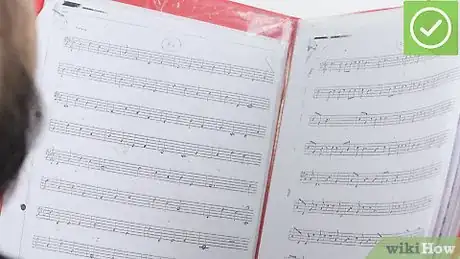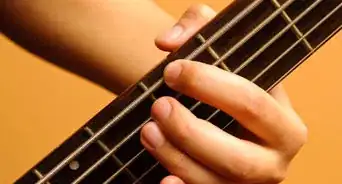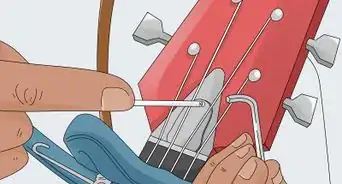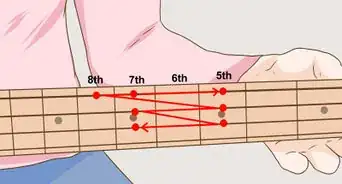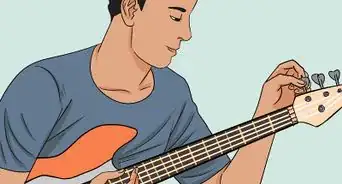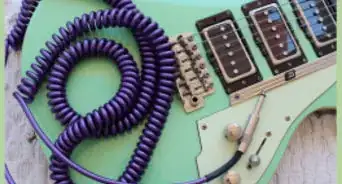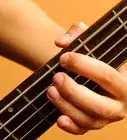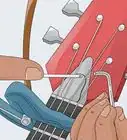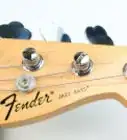This article was co-authored by Michael Papenburg. Michael Papenburg is a Professional Guitarist based in the San Francisco Bay Area with over 35 years of teaching and performing experience. He specializes in rock, alternative, slide guitar, blues, funk, country, and folk. Michael has played with Bay Area local artists including Matadore, The Jerry Hannan Band, Matt Nathanson, Brittany Shane, and Orange. Michael currently plays lead guitar for Petty Theft, a tribute to Tom Petty and the Heartbreakers.
There are 8 references cited in this article, which can be found at the bottom of the page.
wikiHow marks an article as reader-approved once it receives enough positive feedback. In this case, 80% of readers who voted found the article helpful, earning it our reader-approved status.
This article has been viewed 147,088 times.
Bass guitar is the harmonic backbone of a musical group or ensemble. Good bass players are invaluable musicians, effortless bridging the drums and guitars to form a grooving, danceable, and melodic beat. Getting started on the bass isn't hard, but mastering it takes a lifetime.
Note: This article covers the electric bass and acoustic-electric bass guitar, not the double bass, which is the large, upright wooden bass played in orchestras and jazz groups.
Steps
Beginning with the Basics
-
1Learn the parts of the bass guitar. If you want to play the bass guitar, you need to understand how to talk about it. A bass is a relatively simple instrument, but knowing the vocabulary is essential:
- Body: The big part of the bass that rests on your lap or along your stomach. It contains the hardware needed to make sound.
- Neck: The long, segmented section that the strings run along.
- Head: The top of the bass, where the strings are wrapped around posts. It holds the tuning pegs (machines), which you turn to tune.
- Frets: The segmented sections on the neck. Each fret represents the location of a different note. Each fret is a semitone.
- Bridge: The area on the body that the strings are threaded into. It is at the opposite end to the head.
- Pick-ups: On electric basses, these are the little rectangular bars in the center of the body. They transmit the sounds you're playing to an amplifier.
-
2Sit upright with the body comfortably in your lap. It is easiest to play while sitting, but if you have a strap you should use it to take some of the weight off.[1] Lay the body lightly in your lap with the neck pointing to your non-dominant hand. So, if you're right-handed, you hold the neck and frets with your left hand.
- Feel free to experiment with a comfortable height. It should be roughly between your collarbones and hips, but you can adjust it within this range.
- You want both arms to be loose and relaxed, elbows slightly bent.
- If you're right handed, your right forearm can rest on the top of the body. Just make sure your thumb, middle finger, and index finger can comfortably reach all four strings.[2]
Advertisement -
3Know the names and notes of all four strings. Of course, there are basses with five, six, or even more strings, but most beginners start on a 4-string bass. On guitars, the strings count upwards, meaning the first string is the closest to the ground when you're playing. The thickest string on top is the fourth string. So, looking at a guitar from the front, the strings would look like:
- 4th String: E
- 3rd String: A
- 2nd String: D
- 1st String: G
-
4Alternate your index and middle fingers to pluck the strings. When you alternate fingers, each only has to do half the work, meaning you can often play twice as quickly. To play a note, keep a relaxed, straight wrist, with your fingers draping down the strings. Pluck the strings with your index and middle fingers like you were "walking" them on the strings.
- Keep your plucking hand as still as possible.
- You don't have to pull hard, just enough to sound out clearly through your amplifier.
- Work on smoothly, consistently alternating fingers without any hiccups or dull notes.
-
5Learn what note names are for each fret on each string. Luckily, this doesn't require memorization once you've learned how the notes work. Remember how musical notes move -- A, A♯, B, C, C♯, D, D♯, E, F, F♯, G, G♯, A. It is alphabetical, going from A to G. Each fret simply moves you one step down the line. So, on the 4th string, the thickest string, no fret at all is an E. The first fret is an F, the second fret an F♯, and so on down the neck.
- There is no such thing as E♯ or B♯. You simply skip right from E to F and right from B to C.
-
6Use a few tricks, like octaves, to help learn notes across the fretboard. To help learn notes, know that any note two frets and two strings down is the same note (albeit higher, which is called an "octave"). So, the 4th string, 3rd fret and the 2nd string, 5th fret are both Gs, though the second on is a higher pitched octave. Octaves make learning notes much easier.
- A note one string down and five frets backward is an identical note. So, the 4th string, 7th fret is an B, as is the 3rd string, 2nd fret. They should sound almost identical.[3]
-
7Press a string right behind the fret to sound out the note. "Behind" means to the left of the fret of the note you want to play. If you need to play the 2nd fret, you press the string down behind the 2nd fret. You don't need to play right on top of the fret. The closer you can get to the fret, however, the better the note will sound, so you want to be right behind the 2nd fret to get the best tone.
- As you get started, you'll find it hard to always land right behind the fret. Practice a finger position that gets you a smooth note without buzzing and the speed will come later.
-
8Fret with the outside edge of your fingertips. Feel your fingertips, noticing the hard area right near the edge of your fingernail. This is the best place to hold the strings, just a bit to the outside of the fleshy fingertip. Because it is a bit harder of an area, you won't have to press quite so hard on the frets to get a good sound.
-
9Read tablature to learn almost any song for free off the internet. This is a good way to get comfortable playing. Tablature also called "tab" is a simple, web-friendly way of writing out guitar and bass parts. Almost any song you could ever want to learn is available online by searching "My Song Bass Tab." Furthermore, learning the system is easy: each line represents a string, and the numbers on it tell you what fret to play. The following example would play the 2nd fret on the 4th string three times, then the 4th fret on the 2nd string three times:
- G|-----------------------------|
- D|----------------4--4--4----|
- A|-----------------------------|
- E|----2--2--2----------------|
Playing Along with Songs and Bands
-
1Play along to any song by following the root notes of each chord. If you don't know the root notes or chords, just ask. For example, say the song's chords are G, C, and then D. You want to play a G when the guitarist plays a G, a C with his C, and switch to D when he switches to D. If you're just getting started, this works for more complex chords too -- you could play the same three notes if the chords were G7, C7, and D7.
- For beginners, just focus on these root notes. As you get better, start experimenting with the same notes in other areas. The open 2nd string is a D, but so is the 3rd string, 5th fret!
- Work on transitioning right in time with the guitarist. You want to hit the first C note right as she hits the first C chord.
-
2Time your notes up to the kick and snare drums. One of the bass's primary functions is to bridge the gap between the rhythm section (drums) and the other melody instruments (guitar, vocals, piano, etc.) To do so, you have to be locked into both, playing the right root notes to fit the melody and the right rhythm to fit the drums. Good ways to do this are to think in frequencies:
- Play a lower note to time up with the low-frequency kick drum, hitting this deep bass not together.
- Play a higher note (like the same note's octave) to fit in with the snare drum.[4]
-
3Learn to "walk" between notes. The walking bassline began in blues and jazz but has since expanded to all types and genres of music. It is the simplest way to bridge your root notes and start expanding your playing through songs. To begin doing so, simply try playing each fret between two notes on the same string. For example, say the song goes from an E to an A. The following "walk" helps you fill the space between changing chords:
- G|-----------------------------|
- D|-----------------------------|
- A|-----------------------------|
- E|----0--1--2--3--4--5-----|
- You'll notice that some notes don't sound as good as others. As you get better, you'll learn to walk up and down using only the notes in your scales.
-
4Practice with a metronome, as perfect timing is essential for great bassists. You want to play limited notes, but you want every single note to hit the listener hard. The only way to do this is to keep a strong, regular rhythm, which makes practicing with a metronome essential. You should always focus on landing on the beats, practicing in 4/4, 8/8, and even 3/2 with your metronome.
- Rock bassists tend to create a rocking, bouncing feel by landing hard on the 2nd and 4th beats.
- Funk bassists must hit the 1st and 3rd beats harder than the other two -- this is one of the roots of the genre.
- Reggae and ska bass tend to focus on the in-between beats -- the "1 and, 2 and, 3..." beats.
-
5Change your picking location and style to change your sound. Plucking the guitar near the neck produces a warmer sound. Plucking near the bridge has a brighter and more percussive tone. And switching to a pick gives you a harder, sharper edge to your notes. If you're really looking to extend your range, you can learn to play slap bass, producing the unique, loud tones made famous in the Seinfeld soundtrack.
- The aggressiveness you pluck with will also dramatically change the sound.
- Palm muting is when you drape the edge of your hand on the bridge while picking, giving a quiet, percussive, and plodding sound to your notes.
- Always think about what tone best fits the song. Harder, more rocking genres like punk tend to want louder, more percussive playing, while softer tones are used in a variety of genres.[5]
-
6Add fills -- little improvised or creative sections -- when you're given some space. When you want to add a little flourish or flair, pick moments where the band gives you space -- when there are no vocals, during moments the lead guitarist is quiet, or in and out of transitions. Fills are your chance to show off for a few notes, and they are an essential part of keeping the bass interesting without stepping on anyone's toes.
- When playing a fill, try to time it up with a drummer's fill. This usually comes right before the song transitions in some way.
- Remember that the roots notes are always most important. When in doubt, play the root notes.
-
7Service the song instead of trying to show off. Great bass players know that they are responsible for a song's groove-- the almost subconscious feel that gets people dancing or moving. But a busy, technical, or flashy bassline is very hard to groove to and often drowns out guitar, piano, and vocal parts. A huge part of successful bass playing is showing restraint.
- Remember -- root notes come first, forming the melodic backbone of the song. Any flourishes must come after you've mastered these notes.[6]
Growing as a Bass Player
-
1Learn the major scale to greatly increase your note range when playing. You must, at a minimum, learn the major and minor scales. These two scales, played across the guitar, can guide you throw 90% of the songs thrown your way. If a song is in the key of C-major, you have the entire C-major scale at your disposal. The following scale is for A-major, but you simply start it on whatever note you want to put it in the key of this note. Bolded notes are the roots, or the two A notes.
- G|--4-------6----7-----|
- D|--4------6---7---|
- A|--4---5-------7-----|
- E|-------5-------7-----|[7]
-
2Master the minor scale for a slightly more moody set of notes. The minor scale generally has a "darker" or more "moody" tone to it. The A-minor scale located below is a good fit for songs in A-minor. Again, bolded notes indicate root notes.
- G|--4--5-------7------|
- D|------5-------7------|
- A|------5-------7--8--|
- E|------5-------7--8--|
-
3Learn how the major and minor scales are combined to play even further down the neck. This handy trick will double the number of notes at your disposal when playing songs, though it is important to note that they still have different feels. To find the notes, take the major scale in the key you're playing, for example, the A major shown above. If you start a minor scale on the sixth note of the major scale, in this case the 2nd fret F# (on the E string), all of these notes will fit in your song as well!
- Otherwise put, a song in A-major can use either the A-major scale or the F#-minor scale. The F# minor scale is called the relative minor of A major.
- This relationship between major and relative minor holds up and down the fretboard, for all major scale keys. For any major key, you go two scale notes down from the root of the major scale and that gives you the relative minor. For example, in the key of C Major, two scale notes down from C is A minor.
- Another chord to learn is the dominant seventh chord. The is a major chord with a flatted seventh note. An A7 chord consists of the notes A, C#, E, and the flatted seventh, G. It is called "flattened" as it is one semitone (one fret) lower than the seventh note of a major scale.
-
4Play the other notes of chords instead of just the roots. For example, you could play just A, E, and D if the chords are A7, E7, and D7. But you could also play some of those 7th notes, which simply mean the 7th note in the associated scale. So, if the guitarist is playing an A7, you can also hit the 7th not in the A-major scale (2nd string, 6th fret) to sound amazing.
- If you're struggling with the numbers, just ask the guitarist to show you the chord. All the notes he's playing on his top four strings will match the notes on your four strings.[8]
-
5You can play chord tones lower in pitch than the root, or higher than the root. For example, if the chord is C Major, and you are playing the C root note (3rd fret of the A string), you can play the fifth note G below the C (the G on the 3rd fret if the E string) or the third below the C (this is the open E).
-
6Use accenting techniques to make selected notes stand out. Many bassists can play 10 notes and sound good, but only the best players can play one note and make it sound amazing. Bass is a very physical instrument, and your ability to handle and manipulate the strings is how you wring emotion and power out of every note:
- Vibrato: Keeping your finger on the string, shake your hand up and down. You should hear the note "waving" based on how high or far you shake the string.
- Bends: With your finger on the fret, use 2-3 fingers to push the string up the neck. You should hear the note's pitch change as you bend the string. You can also pull the string downward, too.
- Slides: Play a note and, without taking your hand off the string, slide down (or up) to the next note you want to play, fluidly transitioning down (or up).
- Hammer-Ons: Instead of plucking a note, slam your finger down on the string at the fret you want, sounding it out with just this hand.
- Pull-Offs: When removing your finger from a fret, use your fretting hand to pluck the string instead of coming straight off.[9]
-
7Prioritize the 5th note of each scale when making transitions. If you stick to root notes, their octaves, and the 5th, you can create many interesting, melodic, and moving basslines. The 5th is simply the 5th note in the scale -- even if that particular chord isn't being used. You can slide the 5th note between other roots to effortlessly slide up and down the neck and transition from one root to another. Check the lick below, played over a simple C, G, D chord progression illustrated below.
- G|------------5---------------------------------------------------------------|
- D|---------5-----5--------------------------5--------------------------------|
- A|----3--------------0--3--0---2-------5-----5-----------------------------|
- E|---------------------------------------------------3----------3/10----10--|
- |-C-Major-|-----------------|-G-Major-|--------------------|-D-Major-|
-
8Mute unneeded strings with your other fingers as you play. The bass is a very low, deep frequency, and you'll notice that it shakes the room when played loud. This is great, except when that shaking sounds out the strings you aren't even playing! To avoid this, bass players must use their whole hand to keep other strings mute, which you can do by simply laying a finger on the string to keep it still:
- When you play a note, let your finger come up, resting on the string above it to mute it. Don't pull your hand away from the guitar after plucking. Do the same thing when plucking your thumb downward, resting it on the string below.
- Use your ring and pinky fingers to mute lower strings, resting them on all strings below the two plucking fingers.
- Use your thumb to mute higher strings, resting it on strings above the ones you're playing.[10]
-
9Study music theory. There are endless options available to you, from new scales to modes and melodic tricks, that only come from time spent learning music theory. Start with the basics, like the circle of fifths, before moving on to scale composition and more fun tricks and tips.
- At the very least, learn how to form the pentatonic scales, which are simplified versions of your major and minor scales.
Expert Q&A
Did you know you can get expert answers for this article?
Unlock expert answers by supporting wikiHow
-
QuestionHow can I teach myself bass guitar?
 Michael PapenburgMichael Papenburg is a Professional Guitarist based in the San Francisco Bay Area with over 35 years of teaching and performing experience. He specializes in rock, alternative, slide guitar, blues, funk, country, and folk. Michael has played with Bay Area local artists including Matadore, The Jerry Hannan Band, Matt Nathanson, Brittany Shane, and Orange. Michael currently plays lead guitar for Petty Theft, a tribute to Tom Petty and the Heartbreakers.
Michael PapenburgMichael Papenburg is a Professional Guitarist based in the San Francisco Bay Area with over 35 years of teaching and performing experience. He specializes in rock, alternative, slide guitar, blues, funk, country, and folk. Michael has played with Bay Area local artists including Matadore, The Jerry Hannan Band, Matt Nathanson, Brittany Shane, and Orange. Michael currently plays lead guitar for Petty Theft, a tribute to Tom Petty and the Heartbreakers.
Professional Guitarist
-
QuestionHow many scales should I learn in order to become a good bass guitar player?
 Community AnswerYou should learn all 12 major (ionian), all 12 minor (aeolian), all 12 major pentatonic, and all 12 minor pentatonic scales. Learning some blues scales and some assorted scales also wouldn't hurt.
Community AnswerYou should learn all 12 major (ionian), all 12 minor (aeolian), all 12 major pentatonic, and all 12 minor pentatonic scales. Learning some blues scales and some assorted scales also wouldn't hurt. -
QuestionHow long does it take to become a good bass player?
 Community AnswerIt doesn't matter how long you play, what matters is how much practice you put into it. Same applies to almost all instruments, you can have played the bassoon for 5 years and still be worse than a person who has played the bassoon for 3 years if that person practices more than you do.
Community AnswerIt doesn't matter how long you play, what matters is how much practice you put into it. Same applies to almost all instruments, you can have played the bassoon for 5 years and still be worse than a person who has played the bassoon for 3 years if that person practices more than you do.
References
- ↑ http://www.studybass.com/lessons/bass-technique/holding-the-bass/
- ↑ http://www.learntoplaymusic.com/blog/how-to-hold-a-bass-guitar/
- ↑ https://www.guitarworld.com/lessons/guitarists-guide-playing-bass
- ↑ https://www.guitarworld.com/lessons/guitarists-guide-playing-bass
- ↑ http://www.studybass.com/lessons/bass-technique/plucking/
- ↑ http://www.premierguitar.com/articles/How_NOT_to_Play_Bass_like_a_Guitar_Player_Playing_Bass
- ↑ https://musicmotivated.com/guitar-and-bass-in-the-key-of-a/
- ↑ https://nationalguitaracademy.com/how-to-play-bass-guitar/
- ↑ https://www.guitarworld.com/lessons/guitarists-guide-playing-bass
- ↑ http://www.studybass.com/lessons/bass-technique/plucking/
- Videos provided by MusicCollegeTV
